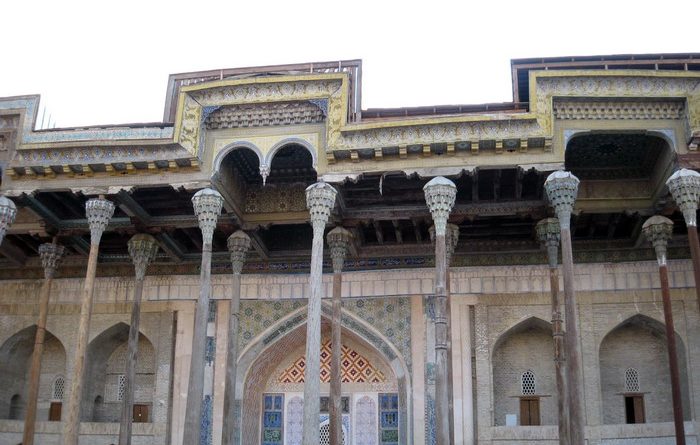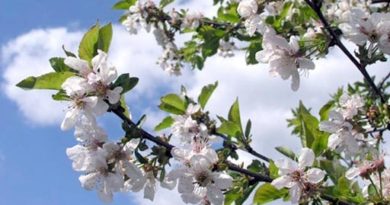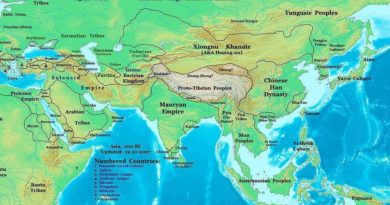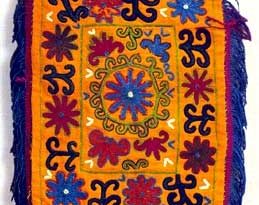Architectural Ceramic of Bukhara
Architectural monuments of Bukhara preserved on its territory are valuable contribution into world art treasury. The richest historical and cultural heritage of the city gives evidence for achievements in the field of architecture and city planning as well as rich information on main periods in progress of architectural decor.
New principles of architectural decor, which should have played important role in aesthetics of medieval architecture of Central Asia, were formed at the turn of the IX – X and XI – XII cc. They were such masterpieces of early-Islamic Central Asian architecture as mausoleum of the Samanids, minaret of Kalyan and Maghoki Attari, the earliest among Bukhara mosques preserved. The rising of architecture onto principally new level was tightly linked with achievements in the field of construction technologies and materials – coming into use of the body brick opened unexpected variety of its combinations forming geometrical patterns. Thus, in the decor of some monuments dominates brick texture with reshaping ornament typical of regional schools of Maverannahr, Fergana and Northern Turkistan. Generally, carved figured bricks – “knot” let in brickwork of double horizontal bricks and “herringbone” brickwork – were especially perfect in structures of Khorasan and Tokharistan.
The architectural decor, initially, had just constructive function but obtained the decorative. The pattern got strict frames of its applying. The system of methods combining constructive design, architectural ornament and applied arts was formed.
Development of construction and pottery had been extending types of architectural decor. From the XII c., the pattern of cut bricks included fragmental blue glazed insertions (epigraphic decor of the mosque of Maghoki Attari, minaret of Kalyan and others). It was the first experience of colour applying in architecture, which later resulted in splendid colour accords that specified the intensively coloured architecture of Maverannahr in the High Middle Ages.
Geometry of the decor formed by the system of figured brickwork caused the domination of Ghirih; the next, more radical step was the appearance of vegetative Islimi patterns, having become possible thanks to technological progress.
Art features of Ghirih and Islimi in the XI – XIII c. linked with Islamic aesthetics proclaimed the domination of ornament becoming integral part of medieval architectural decor and applied arts. They marked the beginning of a new stage in development of art mentality of the feudal epoch. Along with the system of Ghirih and Islimi, the calligraphy, as a new art mean for expression of aesthetic concepts, came into architectural decor. Innovative style of architectural ornaments of the XI – XII cc. became a conclusion of the century-long practice of the people stepping into the next phase of its social and cultural progress.
In the period of the Temurids, a new period of blossoming of arts in Maverannahr terminated by the Mongol invasion, the ornamental art was marked, on the one hand, by further development of traditions going back to pre-Mongol period (Ghirih, Islimi), on the other hand, by the birth of new tendencies (3). In the external finishing of buildings, the polychromic architectural decor obtained special attention (4). Its types were extremely various. Monochromic – blue, dark blue and white – glazed bricks were used either for all-over facing (blue calottes of cupolas) or for pattern insertions on a background of ordinary bricks (mosque of Balyand, medreseh of Miri-Arab and Ulugbeg). Barrier-majolica of the same basic colours where elements of pattern were separated to save clear colour during kilning; cut terracotta combined non-slip details of ornament with coloured slip ones, which accented Ghirih or inscription. Cut slip terracotta – mono- or dichromatic. Smooth majolica of all-over facing with ornamental painting and dissolve enrichment of colours – from two up to seven (blue, white, light blue, black, yellow, red and sometimes unglazed gilt); majolica “lojuvard” – with a bright blue background and fine painting in red, white and gold (mosque of Balyand, medreseh of Abdullakhan and Gaukushan). The most expressive are the combined cut mosaics where elements were separately cut from glazed plates on porous silicate basis – kashine and then formed in all-over ornamental facing (medreseh of Abdullazizkhan and Balyand).
It is worthy to be noted that in the epoch of Amir Temur monumental-decorative art became especially important. It served not only for decoration of buildings but promoted the expression of some ideas of the epoch. Centrality of purpose and style is one of the basic achievements of architecture and architectural ornament of the XIV – XV cc.
It is interesting to note that from the XIV c. the vegetative ornament became dominant over the geometric. Ghirih in its monumental forms as if obtained new features: composed of coloured bricks it occupied huge surfaces of walls, like a spiral, rolled up around the trunks of minarets. However, in usual scale, it lost its variety and complicity, typical of pre-Mongol ornaments. As for vegetative ornament, it was remarkable thanks to enrichment of colour and the character of polychromic tiles. Architectural use of epigraphic also obtained new features. Full texts with tremendous letters of Kufi script covered tholobates of cupolas. The portals were covered with lines of inscriptions performed in literary scripts of a new style: ostentatious Divani (the XIV c.) or harmonic multi-line Sulth (the XV c.) (2). Tile decor sometimes presented at the interiors (panels, mikhrabs), or covered them all-over (for example, in some mausoleums of the XIV c. in Bukhara – memorial complex of Seifeddin-Bokharzi and Buyan-Qulikhan).
Construction works in the XVI – XVII cc. concentrated mainly in Bukhara. Here, the system of “kosh” received its classic performance – two big structures stands oppositely each other at the common central line and are separated either by small empty area (mosque of Kalyan and medreseh of Miri-Arab) or by the street (medreseh of Madorikhan and Abdullakhan), or three buildings framed the square (ensemble of Lyabi-Houze). Among them, there are picturesque memorial ensembles, the country memorial ensemble of powerful Djuibari sheihs, Char-Bakr. Mutual balance of buildings, greatness and architectonic forms, rich and various decor gave extraordinary solemnity to the ensemble in a whole.
In the architecture, a traditional circle of themes, methods and forms had been fixing. Complicated, constructively rational and decoratively effective systems of cupolas on cross arches, shield-shaped and grid pendentive with stalactites insertions had found their best materialization in Bukhara medresehs and khanakas of the XVI – XYII cc. Engineering-constructive basis had obtained here the features of high art expressiveness. On the portal of the mosque of Kalyan the coloured vegetative facing was changed by texture of constructive material (polished brick). In this way the Bukharian masters reached simple but expressive form in the system of crossed arches and shield-shaped pendentive. The specific style of constructive and decorative solution of vaulting and niches had been formed. It had left its mark on the architecture of Bukhara and works of Bukhara architects of the XVI – XVII cc. Such systems present in a line of Bukhara monuments of the XVI c. (medreseh of Miri-Arab, Kukeldash, Abdullakhan, khanaka of Khodja Zainuddin and others), thanks to variety of initial geometric structures they are unique and present a new variant in each case. The last one are close to shapes of Ghirih but much more complicated in performance as they combine constructive and decorative functions. Nevertheless, the moment had come when constructive function subordinated to the decorative purposes. Harmony of architectural forms of mausoleums was being determined by the balanced composition of external and internal decor where were applied cut slip tiles in exclusively various patterns (medreseh of Miri-Arab, Kukeldash, Abdullakhan and Abdullazizkhan). The artist skillfully accented the main details. Thus, facing of frontal facade is more complicated in pattern and more dense in concentration of colour and ornament than in the case of side facades, and tympans of portal arch and its tiles, the most visible place, are the richest in colour and pattern.
The distinction is only in proportions of the basic architectural forms, in fluctuation of their mutual balance and variations of decor combinations. Creative individuality of artists-decorators can be noticed in their work at facades. Various works of coloured glazed bricks are used in wide borders of facade and yard loggias (big patterns in structures of the XVI c, fine and detailed, reminding cross-stitch, in medreseh of the XVII c.). Especially rich is the decoration of tympans with the geometric vegetative (Abdullakhan, Abdullazizkhan) and subject-heraldic pattern (medreseh of Nadir Divan-beghi).
If at the first third of the XVI c. the tile decor was presented by high-quality mosaics, brick and case, in further the searching for cheap and simple facing materials resulted in use of big kashin plates painted in blue, dark blue and white with a pattern (mainly, vegetative) accented by black contour. However, in a process of kilning, the paints were damaged and the pattern and colours became unclear. At the first part of the XVII c., the experience with more high-quality mosaics was repeated again. Since the XIV c., such mosaics have been decorating big and rich in decor structures, which the rulers, clergy and elite constructed. Among them, there are khanakas of the XVI – XVII cc, of Khodja Zainutdin, Faizabad and Nadir Divan-beghi in Bukhara.
Structures of the XVII c. in Bukhara (except medreseh of Abdullazizkhan) with partial ceramic facing differ from structures in Samarkand, reminding the best pieces of the Temurid architecture. For example, at the medreseh of Djuibari – Kalyan just the portal has ceramic mosaic decor. In the case of the Nadir Divan-beghi Ensemble, just main facades have the decor. We can see here pictures of legendary phoenixes and sun birds, like at Sher – Dor. Faience applying reduced much; it was applied only for mosaics, the tiles and majolica were made again of the clay only. Colours of glaze had become of roughly bright tones of yellow, green and blue. The ornament had lost its finesse.
Among the structures of the XVII c. in Bukhara can be pointed out the medreseh of Abdullazizkhan II where were realized the best achievements of architectural decor of the Muslim East. Constructed by the order of the khan, it fixed all architectural and art decorative successes of the XV – XVII cc. The creators of the medreseh, the architect Mukhammad Salikh, artists Mir Khakan and Mukhammad Amin contributed their knowledge, diligence and experience into them. Three-dimensional and planning layout follows the traditional type of Central Asian medreseh (it was constructed simultaneously with Tillya-Kori). The architectural decor, mosaics, majolica and wall painting, is perfect. This is an example of applying of almost all, existing in Central Asia, types of architectural decor. Ceramics presents here in a form of tile work, coloured mosaic on faience and original majolica with relieved ornament where separate right-angled tiles form a panel on definite subject. Use of the forms becoming traditional opened creative opportunities before masters searching for their expressiveness and harmonic combinations.
Without revising of basic principles, innovative features found reflection in the new combinations of these forms and decorative work. Heavy block of peshtak, rushing wave of the portal arch and cupola on well-formed tholobate -such are basic canonized forms of the building composition. Nevertheless, the architecture of the facade is not ordinary. Cupola systems, especially in the entrance hall, summer and winter mosques and darskhana are very effective, giving new variants but variants of the previous founds. For example, in tympans of the big arch of the yard portal there is Ghirih imitating patterns of carved doors of the medreseh of Kukeldash (the XVI c.) and Abdullakhan but in colour of yellow and blue ceramic tiles. Composition of architectural decor of this building is so thoroughly considered and original that it can occupy a place among the unique buildings, which present milestones in development of the architecture. Along with all tendencies towards free painting ornament, revealed in the XVII c., the vegetative-flower ornament still had been tightly linked with definite methods of stylization of natural forms. This method continued to play a role of stable and formed system.
All works of masters of that epoch had integrity of art content. Masters proceeded from their individual experience and taste basing on the system of art vision. This system was tightly linked with general world vision dominating in minds and hearts of the people of that epoch and with inalterability of social relations authorized by Islam.
Author: Suraie Alieva





An attention-grabbing discussion is worth comment. I feel that you must write more on this matter, it won’t be a taboo subject however typically persons are not enough to speak on such topics. To the next. Cheers